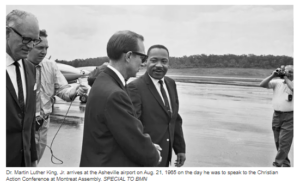
MLK’s trips to Black Mountain & Montreat
“Solicitor Robert S. Swain of Buncombe County said Monday after conferring with law enforcement officers he felt it would be better if Dr. Martin Luther King Jr. did not visit a church meeting at Montreat Thursday. ‘We do not need any outside agitators in this area,’ said Swain in an interview with a local radio station. Swain said he made his remarks in view of the riots in Los Angeles.”
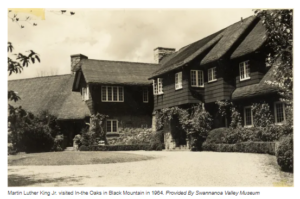
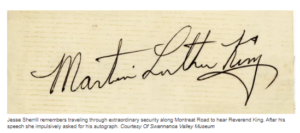
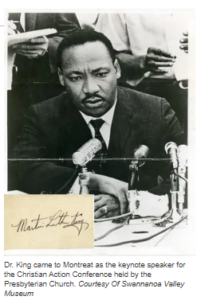
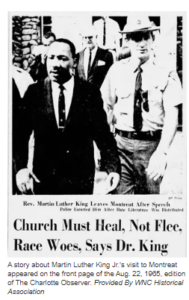
“I had the privilege of meeting Martin Luther King (in 1964),” Black Mountain resident Inez Daughtery recalled in an early 2000s interview. “And he talked to me at length about the things he was going through and the things he was doing. And he told me … ‘Mrs. Daugherty,’ he said, ‘…the work I’m doing. … I know that I am going to die a violent death. … And I live prepared to meet my Maker each day because I know that I will be killed.’ And he was. He was.”
A few months after the murder of four young girls in the bombing of an Alabama church and a few weeks after the assassination of President John F. Kennedy, Martin Luther King Jr. flew to Washington, D.C., to meet with President Lyndon B. Johnson about racial justice. Days later, King flew from Washington to Asheville for a much-needed retreat with members of the Southern Christian Leadership Conference in Black Mountain.
King made many public visits to central North Carolina in the 1950s and 1960s, including to Charlotte, Raleigh, Durham, Greensboro, and Rocky Mount, but he only made two known visits to Western North Carolina – in January 1964 and August 1965. Both visits occurred during key moments in the civil rights movement.
Retreat at In-the-Oaks, Jan. 20-22, 1964
King had been relatively quiet about his plans to retreat in Black Mountain due to impending threats to his life. And on the short drive from the Asheville airport to Black Mountain, King’s party stopped to alert a Highway Patrol Officer that a 1960 white Oldsmobile driven by a white man appeared to be tailing their vehicle.
King was not only concerned about threats from civilians, however. He was also aware of ongoing FBI surveillance. So, he and his colleagues said little publicly about the Black Mountain retreat.
But the FBI still had their sources. From a Dec. 18, 1963, confidential memo, the FBI learned that King had said that he was planning a “retreat like” conference at In-the-Oaks, an estate-turned-retreat center in Black Mountain, which would “give (him and his associates) time to get a little recreation.”
King also mentioned that In-the-Oaks had a swimming pool and bowling alley and that he was “thinking of taking 20 or 30 people … (to) sit down and really discuss the program … for 1964.” King planned for the retreat to be a “where do we go from here discussion.”
Like King, the local media was tight lipped about his visit to the area – but for different reasons. Many editors did not want to seem politically aligned with King. A few larger papers from outside the region, however, did feature coverage of the retreat. One Charlotte paper wrote that, according to King, though churches had made progress on civil rights issues, “11 o’clock on Sunday morning is still the most segregated hour in America.”
Decades later, Asheville Citizen reporter Lewis Green remembered being assigned to cover the retreat.
In his memoir, “Of Human Interest,” Green, a white man, recalled, “My beat was normally the police/courts beat, and since there were heavy security considerations about King’s visits, that came under my beat. … (King) would fly into the Asheville Airport, where he was met by functionaries. … Henry P. Clay was Sheriff at that time, and he provided several deputies to escort King’s convoys to the destination and back to the airport. One black officer he always assigned personally to MLK was the late Bruce Steele of West Asheville. I generally rode in one of the cruisers. At that time, King was hotly controversial and in keeping with its policy, the newspaper management did not want very much written.”
No coverage of King’s visit appeared in the Asheville paper until after his departure. The weekly Black Mountain News made no mention of the well-known minister.
And, there is no complete, official account of the retreat, despite the fact that King’s colleagues audio taped their discussions. When one of King’s advisers warned that the FBI was attempting to infiltrate the organization, all recordings of the summit were destroyed.
Martin Luther King Jr. visited In-the Oaks in Black Mountain in 1964.
As formerly-classified documents from the FBI detail, FBI Director J. Edgar Hoover, who feared King would align himself with the Communist party, sent agents to In-the-Oaks. They recruited a local person (name redacted) to spy on King.
Ultimately, little was reported to the FBI other than a vague post-meeting summary that read, “they discussed the accomplishments (in the civil rights movement) for 1963, and the program for 1964.”
Still, despite limited records, historians believe that a major focus of the retreat was how to “counter allegations of Communist influence on their movement, and when, where, and how to mount new civil disobedience campaigns.”
Oral histories from those in attendance give a more detailed picture of King’s leisure time in Black Mountain. Reverend C.T. Vivian, who attended the summit, told historian Ben Kamin, “(King) did sometimes (unwind) during those days in the mountains, believe it or not. … There was some relaxing time and jokes and fun. We took breaks and played softball and Ping-Pong, cards, and Martin just seemed to let off a lot of steam.”
In an early 2000s interview, Inez Daughtery recalled, “I was working at In-the-Oaks down at the Episcopal Center, and they came for a retreat. (King), Andrew Young and Ralph Abernathy and their group.”
Though King had been advised to travel by car rather than plane for better anonymity, he chose to fly. Daughtery remembered, “The minute he stepped off the plane (in Asheville) and got in the terminal, some lady said, ‘Hello, King.’ It was out.”
“Next morning,” Daugherty continued, “the phone was ringing all day (at In-the-Oaks), looking for King. (They’d say), ‘He’s in this area, somewhere and we want to find him. We want to know where he is.’”
“So finally, about five o’clock that evening, Henry Clay, the sheriff … called. … I said, ‘Mr. Clay, I want to ask you something.’ He said, ‘What?’ I said, ‘What do you want with Mr. King?’ He said, ‘Well, Inez, a man of his stature, status and all,’ he said, ‘people want to do him harm. Wherever he is, I want to give him protection.’ So, I said, ‘Well, I’ll talk to my manager and he’ll talk to you and tell you if he’s here or not.’ And (Clay) sent (Bruce Steele) out to patrol the area.”
“And, one afternoon, there’s a young white man came (and) rang the bell. ‘I heard King is here.’ (The young man) was going to come in the house. Well, they didn’t know whether he wanted to see (King) or do him harm so they got the police to get him away from there.”
Despite these minor threats, the retreat itself seemingly went off without any major hitches.
The most significant trouble came as King’s party departed Black Mountain. The group boarded an 8:30 p.m. departing flight from Asheville to Atlanta and were immediately asked to deplane. There was an active bomb threat. As King walked back to the airport from the plane, he remarked to a staff member, “I’ve told you all that I don’t expect to survive this revolution; this society’s too sick.”
According to an FBI memo, a female, who identified herself as a telephone operator from Birmingham, Alabama, called the Asheville Airport and asked to speak with King.
King’s assistant, Wyatt Tee Walker, took the call. The woman told Walker, “You had better get that S.O.B. out of Asheville, North Carolina. I hope there is a bomb on the plane,” then hung up the phone.
Apparently, the same woman had called the day previously and said “something about they better get Marth Luther King out of Black Mountain before somebody kills him,” and had also called twice before King arrived at the airport on the 22nd to ask where King was staying and what flight he was on out of Asheville. There was some hesitancy among local officials about whether the call was long-distance or local. The plane was searched. No bomb was located, and the plane departed Asheville at 11:17 p.m. King and his party arrived home safely.
The bomb scare did make local papers, likely because Asheville Citizen reporter Lewis Green managed to sneak onto the plane to help search for the bomb.
Following the search, Green – a controversial figure in town at the best of times – had a conversation with King in the airport waiting room. King asked him, “Now, as a middle-class white man, what are you doing for Civil Rights?” Green denied being middle class and told King, “I’m active in programs on alcoholism. I just can’t save the whole world. You take care of the black problem and I’ll handle what drunks I can, black or white.”
Still, at the time, Green only wrote in the newspaper, “King declined to comment while he waited except to observe this was the first time he had been forced to leave a plane.”
Newspapers across the United States, and even into Canada, covered the bomb threat, but wrote little, if anything, about the retreat itself.
Keynote speech at Montreat’s Anderson Auditorium, Aug. 21, 1965
Over a year and a half later, King returned to Western North Carolina, this time for a public appearance as the keynote speaker at the Christian Action Conference of the Southern Presbyterian Church. The conference theme was “The Church and Civil Rights.”
King had originally been set to open the three-day event but was delayed by a major riot in the Watts neighborhood in Los Angeles. King detoured to LA to help diffuse the tension, then made his way to North Carolina, arriving on Aug. 20, 1965.
In the months leading up to the conference, the Presbyterian Church fielded letters, telegrams, and phone calls expressing strong feelings about King’s planned speech – some in support, many in opposition. An Aug. 6, 1965, article in the Asheville Citizen entitled “King’s Montreat Talk Already Stirs Unrest,” reported “King’s scheduled speech at Montreat, N.C., this month has caused considerable controversy. … The invitation to King had brought communications opposing it. But … there were also communications commending the board for its action.”
Opposition to the King’s presence at the conference had been ongoing for months inside and outside the church. Shortly after King had been invited and agreed to be the keynote speaker for the conference, a South Carolina elder within the Presbyterian organization had requested that the General Assembly of the Presbyterian Church withdraw the invitation. But the General Assembly voted 311 to 120 to reject the request. Though the church continued to receive opposition, there was no further discussion of rescinding his invitation.
As the date of King’s speech approached, the FBI — as they simultaneously worked to discredit the civil rights icon — were on high alert for any threats to King’s security. On Aug. 14, 1965, an informant told the FBI that he had overhead “a man, whose name he did not know, say something about having two 8 millimeter rifles which would pinpoint a target 500 yards. When asked what he was talking about, he said, ‘I guess he was talking about that S.O.B. who is coming to Montreat next week.’” The FBI informed law enforcement in Asheville.
On Aug. 15, white evangelist Billy Graham, who made his home in Montreat, spoke about the L.A. riots to an “overflow” audience in Anderson Auditorium, where King was scheduled to speak in two days’ time.
A staff writer for the Asheville paper wrote on the front page alongside headlines about the riots, “Although he didn’t name any individual, it could be inferred that he was referring to Dr. Martin Luther King Jr. (when he said), ‘Any religious leader can express his personal views as an individual. However, President Johnson and the Congress are perfectly capable of handling American foreign affairs if they have the support of the people.’” Graham was specifically referring to King’s outspoken critiques of the Vietnam War.
As the nation watched the L.A. riots, concern among local residents and law enforcement about King’s visit grew. A Tuesday, Aug. 17, 1965, article in The Charlotte Observer entitled “Don’t Visit N.C., King Told,” read “Solicitor Robert S. Swain of Buncombe County said Monday after conferring with law enforcement officers he felt it would be better if Dr. Martin Luther King Jr. did not visit a church meeting at Montreat Thursday. ‘We do not need any outside agitators in this area,’ said Swain in an interview with a local radio station. Swain said he made his remarks in view of the riots in Los Angeles.”
A story about Martin Luther King Jr.’s visit to Montreat appeared on the front page of the Aug. 22, 1965, edition of The Charlotte Observer.
Swain continued by asking “that there be no demonstrations against the King visit” and that “there was always an element in a community that could cause trouble.” He felt King’s visit might “set them off.”
And, on the day King was set to arrive, “’anti-King’ literature was distributed … at this usually peaceful community, the home of The Rev. Billy Graham, the evangelist, by ‘a lot of people who were unknown … a rough looking group.’”
Henry P. Clay was still sheriff of the county. He had received reports “that certain outside violent hate groups ha(d) planned demonstrations and law-breaking acts at this gathering,” but declined to name the groups. “We’ll screen everyone coming in,” he said, “and we’ll search autos and individuals for guns if necessary.”
The Asheville paper, which had only covered King’s impending visit on page 18 the day before, placed news of the delay of his talk on the front page with the reason for his cancellation – “he is visiting Los Angeles.”
King rescheduled his talk for Saturday, Aug. 21, 1965, at 2 p.m. He arrived at the Asheville airport at 1 p.m. Five sheriff’s deputies escorted King from the airport to Montreat.
Sheriff Clay told the Asheville paper that “the sole responsibility for the safety of King has been thrust upon my department by the Federal agencies.” As such, though the speech was supposed to be open to the general public, Clay said he would refuse entrance to anyone who did not have “business there.” Clay continued, “It is my intent that this county remain peaceful and law-abiding. Recent happenings such as those in California, Chicago, and Massachusetts will not occur in Buncombe County.”
Glenn and Evelyn Bannerman, two long-time white Montreat residents, recalled of King’s visit, “People were concerned about what might happen and what demonstrators might do to the extent that some of the Montreat maintenance staff armed themselves with (pistols) because somebody feels like something’s going to happen.”
Montreat remained peaceful that day. King took the podium and spoke for nearly an hour to a crowd of hundreds – perhaps thousands. “The greatest challenge facing the church today is the racial situation,” King said to the audience. After the speech and a question and answer session, King greeted the gathered crowd. One local resident and member of Black Mountain’s Black community, Jessie Sherrill, impulsively asked for his autograph.
King was escorted back to the airport. His flight took off just after 5 p.m. without incident.
Fifty years later, in commemoration of King’s speech in Montreat, the Montreat Conference Center hosted another three-day conference in Anderson Auditorium entitled, “King’s Unfinished Agenda: A Teach-In for Rededicating Ourselves to the Dream.”
Keynote speaker, activist and Pulitzer Prize winner Leonard Pitts, speaking exactly 50 years after King from the same pulpit, said, “Half a century ago, Martin Luther King came to this place fresh from a riot in … Los Angeles to give a speech. If you listen closely, much of what King had to say was actually about the church’s failure … about its moral timidity, its refusal to lead in the cause of justice. ‘People of faith’ said King, ‘have an obligation to speak up for racial justice’ but … ‘we must admit … that all too often the church has been lax at this point. All too often, in the midst of social evil, too many Christians have somehow stood still only to mouth pious irrelevancies and sanctimonious trivialities. All too often, in the midst of racial injustice, too many Christians have remained silent behind the safe security of stained glass windows.’ And so, here we are.”
Anne Chesky Smith is the executive director of Asheville Museum of History.
